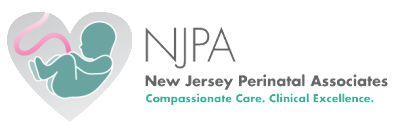NJPA May 2012 Newsletter
In this newsletter…
- Management of pregnant women aged 40 and over
- Timing of delivery in patients with previous uterine surgery
- Meet our perinatologist
Advanced Maternal Age and the Risk of Antepartum Stillbirth
Approximately 14.2% of women who give birth in the United States are 35 years of age or older and 2.6% are age 40 or older. The last three decades have seen a remarkable increase in first births among women aged 40 to 45.
The rate of stillbirth in the United States is 6.4 to 7.8 per 1000 live births. After adjusting for coexisting conditions, a recent meta-analysis demonstrated increasing odds of stillbirth with increasing maternal age with the risk doubling for women age 40 or older (Odds Ratio 2.29).
In women deemed to be at increased risk of stillbirth, antepartum fetal surveillance is recommended. Although advanced maternal age is recognized as a risk factor for stillbirth, antepartum fetal surveillance has not been routinely recommended. Evidence in favor of antepartum surveillance starting at 37 weeks is that the risk of stillbirth at this gestational age is similar in frequency to other high-risk conditions for which testing is routinely performed such as intrahepatic cholestasis of pregnancy, insulin dependent diabetes and chronic hypertension.
This issue of our MFM newsletter describes the best practices for the management of pregnancy in women aged 40 or older.
Best Practice for the Management of Pregnancy in Women Aged 40 and Over
- Genetic counseling and first trimester screening should be performed between 11 and 14 weeks gestation
- A Level 2 ultrasound should be performed between 18-20 weeks gestation
- Assessment of fetal growth at 32 weeks gestation
- Weekly antepartum testing beginning at 36 weeks gestation
- Membrane sweeping should be considered weekly beginning at 37 weeks gestation
- Delivery should be accomplished by the EDD
Timing of Delivery in Patients with Previous Uterine Surgery and Placenta Previa
Preterm birth, defined as delivery < 37 weeks gestation, is a public health concern affecting more than 500,000 pregnancies in the United States each year. Late preterm (34 0/7 to 36 6/7 weeks) and late term (37 0/7 to 38 6/7 weeks) births are associated with an increasing proportion of neonatal morbidity and the practice of elective delivery before 39 weeks gestation has been increasingly discouraged. The goals of early delivery are to avoid acute catastrophic maternal complications and to limit the potential for fetal death or compromise.
The NIH in conjunction with the SMFM sponsored a workshop in February of 2011 to develop consensus guidelines regarding the optimal gestational age for delivery of patients with concomitant placental, maternal or fetal conditions. This was published in the August 2011 issue of Obstetrics & Gynecology.
The authors comment on the issue of amniocentesis for the purpose of predicting fetal lung maturity. The recommendations are that in general, if an indication for delivery is present, the use of amniocentesis to assess fetal lung maturity does not assist in guiding management.
NJPA has agreed on the best practice for delivery timing in women with:
- Previous classical cesarean section
- Delivery at 36-37 weeks gestation via repeat cesarean section without an amniocentesis
- Previous myomectomy necessitating cesarean section
- Delivery at 38 weeks without an amniocentesis
- Stable placenta previa
- Delivery at 36-37 weeks gestation without an amniocentesis
Meet Our Perinatologist
 Linda Peláez, MD
Linda Peláez, MD
Dr. Peláez graduated from the Albert Einstein College of Medicine. She completed her residency in obstetrics and gynecology at the New York Presbyterian-Weill Cornell Medical Center. She stayed on as faculty to complete her fellowship training in maternal-fetal medicine at Cornell University in New York. Research interests of Dr. Peláez include fetal diagnosis and risk assessment and multiple gestations. Dr. Peláez joined NJPA in July of 2010.
To download this newsletter, please click here.
